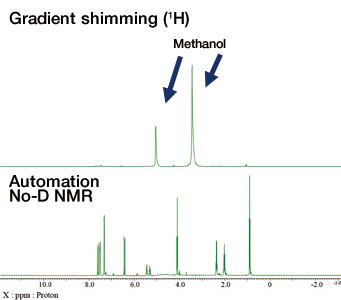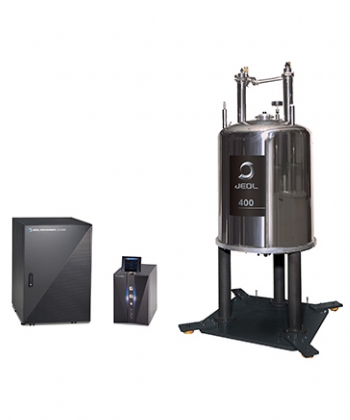ECZR NMR spectrometer (JNM-ECZR series) Model:JNM-ECZR NMR
The ECZR NMR spectrometer (JNM-ECZR series), a member of the JNM-ECZ series of instruments, is a new research system that fully incorporates the latest digital and high frequency technologies. rosette_wraply reliable, yet in a more compact size made possible by incorporating advanced integrated circuits, it supports even greater expandability options than current models for multi-channel operation, high power amplifiers and other accessories. The bus line for control of attachments has been upgraded to even higher speed and enables highly accurate and rapid control.

-
∎ Features
Spectrometer Control Computer
The JNM-ECZ spectrometer control computer(SCC) is a high performance computer with large capacity hard disc, and is used for execution of pulse sequences, signal-to-noise calculation during measurement, storage of data, data processing, etc. are all possible and independent of the workstation.
All measured data is written to the SCC hard disc without fail, thus the SCC also serves as a data server.
Even if there is any kind of failure to the workstation computer or network during sequential measurements, all measurements that were submitted will be executed normally and the results will be written to the SCC’s disc. Even in a multi-user environment where many users require different measurements and processing, stable operation of the instrument is assured.Multi-Sequencer
The sequencer controls RF, lock and PFG channels during pulse sequence execution. The JNM-ECZR spectrometer can use multiple slave sequencers which control each of these channels, and a master sequencer which synchronizes all slave sequencers. Individual slave sequencers can execute pulse sequences irrespective of synchronous or asynchronous. Thus, by controlling several slave sequencers by the master sequencer, any NMR pulse sequence can be carried out.
Hence, the JNM-ECZR spectrometer can accommodate up to 8 nuclei, 32 frequency sources and PFG simultaneously. It can compile and execute any complex pulse sequence, even those that may be developed in the future.STS (Smart Transceiver System)
The Smart Transceiver System (STS) is a highly advanced integration of RF sequencer, DDS (Direct Digital Synthesizer), FSU (Frequency Synthesizer Unit), transmitter, receiver, acquisition unit and gate control unit into a single transceiver board. This is equivalent to integrating the basic composition of an NMR system onto one board.
The standard instrument composition is one source with 2 nuclei, 8 frequencies and one receiver. The JNM-ECZR spectrometer can accommodate up to four RF transceiver boards, and so can support 8 nuclei, 32 frequencies and 4 receivers.Highly Precise Digital Control
The STS used in the JNM-ECZR spectrometer realizes control at the highest speed for frequency, phase and amplitude modulation, with a control time resolution of just 5ns. This high speed digital control is extremely useful for high speed phase modulation pulses which are required for the most recent NMR pulse sequences. The same time control performance is offered for various external systems.High Performance DDS
The DDS (Direct Digital Synthesizer) unit of the JNM-ECZ spectrometer available from the STS, can create a very wide offset range.
Using an appropriate probe, this enables a “pseudo 3 nucleus” measurement with the standard instrument. For example, 13C{1H}{19F} measurement is possible with the standard configuration of JNM-ECZ spectrometers.Receiver
The receiver of the JNM-ECZ spectrometer is controlled by the sequencer. A reference frequency generated in the receiver can be dynamically modulated for phase and amplitude even during FID sampling.
DQD (Digital Quadrature Detection) by high speed A/D conversion at 16 bit 100 Msps, not only improves the effective dynamic range for quantized noise, but also reduces unwanted signals such as IMD, by over-sampling at high rates. In addition, the digital receiver filter optimized for NMR ensures accurate quantitative results.
The high dynamic range of the JNM-ECZ spectrometer enables the observation of very small signals. The 13C satellite signals of acetone in a mixed sample of H2O:DMSO:Acetone=18570:104:1 (approx.10 % D2O) are clearly observed (approx.1/3400000).Multi-sequencer and Multi-dimensional NMR measurement
The JNM-ECZR spectrometer can control up to four RF sources, thus 8 nuclei and 32 frequencies, using the multisequencer method, with each RF source controlling 2 nuclei and 8 frequencies. Intelligent control of multiple RF sources enables not only highly precise execution of complex multi-dimensional NMR measurements, but allows the use of parallel expressions within the pulse sequence. In addition, by using conditional statements within a pulse sequence, more than one experiment is possible using the same pulse sequence program.Digital NMR Lock Circuit
Application of STS technology provides high precision and high speed digital control of the 2H lock. This new digital feedback circuit offers extremely efficient control of the magnetic field against external modulation.
The precise digital lock feedback mechanism thus enables highly stable operation for protracted measurements.Shimming
The gradient shim capability of the JNM-ECZ series is not limited to observation of deuterium (2H) as is normally used, but also other nuclei such as 1H or 19F. Such functionality is useful for “No-D NMR™” and can also be used for measurement of solids.What is gradient shimming?
This is a high speed shimming method that measures the magnetic field distribution (magnetic field map) of the sample, compares it to a standard map then calculates and applies the required shim values for correction so that the magnetic field map becomes uniform.

Spectrum before and after resolution adjustment by gradient shimming. At 49 sec. resolution has improved.

No-D NMR measurement using resolution adjustment by selective pulse gradient shimming where the solvent has multiple signals (top). Solvent signal is automatically suppressed by the ‘WET’ method (bottom).

Resolution adjustment is possible by gradient shimming in the same manner as 2H, by selecting the 19F signal.
The temperature control system enables stable measurements using a newly-designed heater with improved response. The JNM-ECZ spectrometer allows faster and more stable operation of peripheral devices using the new high speed bus control line.
Temperature Control System

The head amplifier chassis has various functions related to probe and the super conducting magnet. A touch-panel display is located on top of the head amplifier chassis, offering an intuitive user interface.
Head Amplifier Chassis
During probe tuning, reflection dip and reflection value are indicated, whilst during cryogen refilling, the actual level of cryogen in the magnet is indicated in real time. It makes the routine maintenance related to probes and super conducting magnet convenient and efficient.



The Power Amplifier amplifies the RF pulse and outputs it to the probe. Various models are available depending on the purpose but all power amplifiers exhibit excellent linearity and response performance.
Power Amplifier
The JNM-ECZ spectrometer is designed so that the power amplifier keeps constant thermal stability, regardless of output / non-output of RF pulses. Thus stable RF output is achieved for every kind of measurement, regardless of number of pulses, pulse widths, intervals etc. used within the pulse sequence.

PFG(Pulsed Field Gradient)
PFG (Pulsed Field Gradient) control by STS (Smart Transceiver System) technology offers technical advantages.
The new PFG control offers higher precision and stability for measurements that requires highly precise control such as DOSY, etc.
PFG Amplifier
For the JNM-ECZR series, two models of PFG amplifier with different power outputs, 10 A and 30 A. are available. Please discuss with your local JEOL representative which is more suitable for your application.Improved functionality and unique design
The spectrometer features enhanced functionality, ease of operation and an attractive design.Intuitive control software
Incorporating an additional interface for simple, routine operation, the Delta software for spectrometer control and data processing supports both simple and sophisticated applications. A minimum sequence of operation is needed for routine, standard analysis, such as selection of a solvent or measurement mode. For more complicated analysis with numerous conditions, the system will automatically define hardware parameters, including those for the spectrometer and probe, allowing the operator to set up only the conditions specific to the sample or research objective.

Flexible room layout
Compared to the JNM-ECAⅡ series, the spectrometer requires a 67 % more compact size.
All system units, including the magnet and compact auto multi sample changer, can be laid out efficiently in a small room.

Solid measurement
TJNM-ECZR enables measurement not only of solutions, but also of various solid state NMR samples. The spectrometer is compatible with many optional probes including:- world’s fastest sample spinning 0.75mmφ,
- ultra fast 1mmφ MAS probe,
- convenient 4mmφ,
- HXMAS probe 3.2mmφ,
- large capacity 8mmφ,
- FGMAS for semi-solids.
A newly-developed MAS controller controls sample spinning from low speeds to high speeds, safely and stably. In combination with the highly stable RF control of JNM-ECZ, it can accommodate many solid state sample measurements. -
Specification
Instrument Instrument Stray magnetic field (0.5mT lin) Ceiling height (m) 500 MHz 0.6 1.15 2.51 600 MHz 0.7 1.4 2.79 700 MHz 0.8 1.6 3.11 800 MHz 1.5 2.5 3.45
-
- Application of diffusion filter - suppression of signal of small molecule
- 20 T/m high field gradient strength diffusion measurement system
- Fast MAS solid-state NMR toolbox for biomolecules
- How to use LR-HSQMBC: Observation of very small couplings
- Separation of 13C spectra of polyurethane soft and hard segments by ROSY
- NMR software DeltaV5.3.2 Introduction of new features ~"pure shift" (4)~ HSQC
- 2D homonuclear correlation 1H solid-state NMR by wPMLG
- Shortening measurement time by multiple acquisition experiments
- Experimental set-up of high-resolution 1H solid-state NMR by wPMLG
- Observation of NOE by HSQC-NOESY








